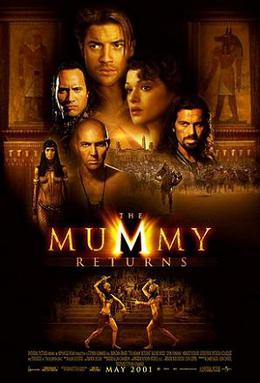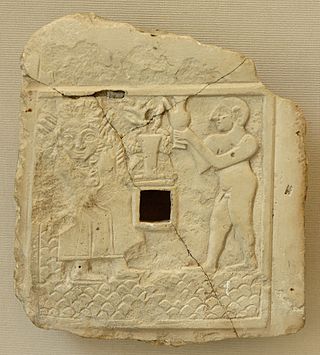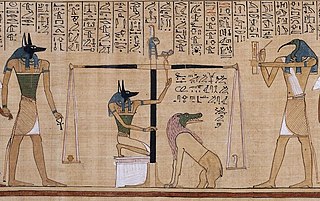
The afterlife or life after death is a purported existence in which the essential part of an individual's stream of consciousness or identity continues to exist after the death of their physical body. The surviving essential aspect varies between belief systems; it may be some partial element, or the entire soul or spirit, which carries with it one's personal identity.

Anubis, also known as Inpu, Inpw, Jnpw, or Anpu in Ancient Egyptian, is the god of funerary rites, protector of graves, and guide to the underworld, in ancient Egyptian religion, usually depicted as a canine or a man with a canine head.

Hades, in the ancient Greek religion and mythology, is the god of the dead and the king of the underworld, with which his name became synonymous. Hades was the eldest son of Cronus and Rhea, although this also made him the last son to be regurgitated by his father. He and his brothers, Zeus and Poseidon, defeated their father's generation of gods, the Titans, and claimed joint rulership over the cosmos. Hades received the underworld, Zeus the sky, and Poseidon the sea, with the solid earth available to all three concurrently. In artistic depictions, Hades is typically portrayed holding a bident and wearing his helm with Cerberus, the three-headed guard-dog of the underworld, standing at his side.

Osiris is the god of fertility, agriculture, the afterlife, the dead, resurrection, life, and vegetation in ancient Egyptian religion. He was classically depicted as a green-skinned deity with a pharaoh's beard, partially mummy-wrapped at the legs, wearing a distinctive atef crown, and holding a symbolic crook and flail. He was one of the first to be associated with the mummy wrap. When his brother Set cut him up into pieces after killing him, Osiris' wife Isis found all the pieces and wrapped his body up, enabling him to return to life. Osiris was widely worshipped until the decline of ancient Egyptian religion during the rise of Christianity in the Roman Empire.

In ancient Greek mythology and religion, Persephone, also called Kore or Cora, is the daughter of Zeus and Demeter. She became the queen of the underworld after her abduction by her uncle Hades, the king of the underworld, who would later also take her into marriage.

Ammit was an ancient Egyptian goddess with the forequarters of a lion, the hindquarters of a hippopotamus, and the head of a crocodile—the three largest "man-eating" animals known to ancient Egyptians. In ancient Egyptian religion, Ammit played an important role during the funerary ritual, the Judgment of the Dead.

The Duat is the underworld in ancient Egyptian mythology. It has been represented in hieroglyphs as a star-in-circle: 𓇽. The god Osiris was believed to be the lord of the underworld. He was the first mummy as depicted in the Osiris myth and he personified rebirth and life after death. The underworld was also the residence of various other gods along with Osiris.

In ancient Egyptian religion, Apis or Hapis, alternatively spelled Hapi-ankh, was a sacred bull or multiple sacred bulls worshiped in the Memphis region, identified as the son of Hathor, a primary deity in the pantheon of ancient Egypt. Initially, he was assigned a significant role in her worship, being sacrificed and reborn. Later, Apis also served as an intermediary between humans and other powerful deities.

The ancient Egyptians believed that a soul was made up of many parts. In addition to these components of the soul, there was the human body.

Sheol in the Hebrew Bible is the underworld place of stillness and darkness which lies after death.

The Mummy Returns is a 2001 American action fantasy film written and directed by Stephen Sommers, starring Brendan Fraser, Rachel Weisz, John Hannah, Arnold Vosloo, Oded Fehr, Patricia Velásquez, Freddie Boath, Alun Armstrong, and Dwayne Johnson in his film acting debut. The film is a sequel to the 1999 film The Mummy and was distributed by Universal Pictures.

Anput is a goddess in ancient Egyptian religion. Her name is written in hieroglyphs as jnpwt. In English, her name also is rendered as Anupet, Input, Inpewt, and Yineput. As the female counterpart of her husband, Anubis, who was known as jnpw to the Egyptians, Anput's name ends in a feminine "t" suffix when seen as jnpwt.

In ancient Greek cult-practice and literature, a nekyia or nekya is a "rite by which ghosts were called up and questioned about the future," i.e., necromancy. A nekyia is not necessarily the same thing as a katabasis. While they both afford the opportunity to converse with the dead, only a katabasis is the actual, physical journey to the underworld undertaken by several heroes in Greek and Roman myth.

Serapis or Sarapis is a Graeco-Egyptian god. A syncretic deity derived from the worship of the Egyptian Osiris and Apis, Serapis was extensively popularized in the third century BC on the orders of Greek Pharaoh Ptolemy I Soter, as a means to unify the Greek and Egyptian subjects of the Ptolemaic Kingdom.

In Greek mythology, the Greek underworld, or Hades, is a distinct realm where an individual goes after death. The earliest idea of afterlife in Greek myth is that, at the moment of death, an individual's essence (psyche) is separated from the corpse and transported to the underworld. In early mythology the dead were indiscriminately grouped together and led a shadowy post-existence; however, in later mythology elements of post-mortem judgment began to emerge with good and bad people being separated.
Khenti-Amentiu, also Khentiamentiu, Khenti-Amenti, Kenti-Amentiu and many other spellings, is an ancient Egyptian deity whose name was also used as a title for Osiris and Anubis. The name means "Foremost of the Westerners" or "Chief of the Westerners", where "Westerners" refers to the dead.

A funerary cult is a body of religious teaching and practice centered on the veneration of the dead, in which the living are thought to be able to confer benefits on the dead in the afterlife or to appease their otherwise wrathful ghosts. Rituals were carried on for the benefit of the dead, either by their relatives or by a class of priests appointed and paid to perform the rites. These rituals took place at the tombs of the dead themselves or at mortuary temples appointed to this purpose. Funerary cults are found in a wide variety of cultures.

A vegetation deity is a nature deity whose disappearance and reappearance, or life, death and rebirth, embodies the growth cycle of plants. In nature worship, the deity can be a god or goddess with the ability to regenerate itself. A vegetation deity is often a fertility deity. The deity typically undergoes dismemberment, scattering, and reintegration, as narrated in a myth or reenacted by a religious ritual. The cyclical pattern is given theological significance on themes such as immortality, resurrection, and reincarnation. Vegetation myths have structural resemblances to certain creation myths in which parts of a primordial being's body generate aspects of the cosmos, such as the Norse myth of Ymir.

Ancient Egyptian afterlife beliefs were centered around a variety of complex rituals that were influenced by many aspects of Egyptian culture. Religion was a major contributor, since it was an important social practice that bound all Egyptians together. For instance, many of the Egyptian gods played roles in guiding the souls of the dead through the afterlife. With the evolution of writing, religious ideals were recorded and quickly spread throughout the Egyptian community. The solidification and commencement of these doctrines were formed in the creation of afterlife texts which illustrated and explained what the dead would need to know in order to complete the journey safely.



















